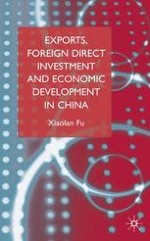2004 | Buch
Über dieses Buch
This volume, based on a series analysis using up-to-date econometric technique, systematically investigates the role that exports and foreign direct investment (FDI) have played in China's development process, and questions the received wisdom that exports and FDI are always an unalloyed blessing. It focuses on the transmission mechanisms through which exports and FDI influence growth and economic development and investigates the impact of exports and FDIs on employment, development financing and productivity growth, amongst other issues, in China.
Anzeige
